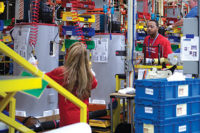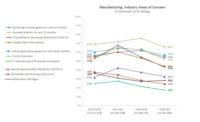Today 3D measurement is a common sight, not only in the quality field, but also for design, reverse engineering and movies.
“In my view, there’s a wave of demand for 3D scanning coming,” says Michael Raphael, CEO and founder of Direct Dimensions Inc. “I think the use of 3D digital data is now widely accepted for many different applications. The idea of what’s becoming known as a digital twin for manufactured products, or fabricated buildings, or even people, is the new reality.”
Perhaps you’ve attended a previous meeting of the Coordinate Metrology Society—this year marks the 35th year of the Coordinate Metrology Society Conference (CMSC)—so you’ve seen a lot of 3D measurement technology. If you attended this year’s event in Orlando, you heard about racing catamarans, inspecting artifacts, and even circling the Earth. Last year’s CMSC featured applications such as CMM calibration at NIST, special effects for Marvel Comics, the challenges of using laser trackers at sea, and the standards development process. In 2017, CMSC included discussions of scanning whale bones, telescopes, airplane wings, and laser scanner standards. In other words, 3D measurement is a fit for many different applications.
During this year’s CMSC keynote, Raphael described trends in 3D metrology, including an application featuring the Avengers movie—but it’s not just superheroes that require scanning. When Quality spoke with him later, he said, “We’re getting calls to work on movies that you wouldn’t even think have special effects.”
The benefits of 3D measurement are numerous—and of course the technology continues to improve. “All have gotten lighter, faster, better,” Raphael says. “Portable systems in factories, trackers, arms, handheld systems, optical systems. I think the OEMs are pushing the capabilities of these systems every year, releasing new products, and leapfrogging each other. It’s a good thing, and we as consumers get better products.”
Although there are a great deal of applications for 3D measurement, the technology may not always be used. Raphael offered the following example. Consider an airplane on the tarmac that is hit with a luggage cart. Nothing could be simpler than using a handheld scanner to capture the extent of potential damage. If you’re only allowed to use a simple tape measure to document the issue, this could lead a host of problems and delays.
For those who are using it, the appeal of 3D measurement comes from many different areas. Alfredo Gandara, business analyst at ATT Metrology Services, says many customers are looking for a way to upgrade their current technology, moving from a manual process to one that is easier, more accurate, and traceable. While the technology has been used for years in the automotive and aerospace industries, “now it is trickling down to small manufacturers,” Gandara says.
The demand for handheld scanners continues to grow, says Gandara, as customers want rapid 3D data collection for product development and analysis. Automation has been another driving factor. “There’s been a large growth in robotic controls, using metrology equipment to track a robot and correct its path,” Gandara says.
Yesterday’s technology didn’t involve robots, and that’s not the only improvement.
“The accuracy has definitely changed, from back in the day with theodolite systems and having to be very technically inclined,” Gandara says. Still, he notes that using an instrument does require an understanding of good metrology practices in order to remove potential sources of error.
What’s next for 3D measurement?
According to Raphael, several companies are offering a single piece of software that operates multiple scanning systems, so you would only have to learn one type of software. He anticipates that tomorrow’s technology will feature better accuracy, lighter weight and more portability. Ease of use continues to improve, he says, and he’s been working with a new handheld scanner that is extremely easy to use. “I’m not kidding you, anybody could use it,” Raphael says. “If you could handle the camera on your phone, you could handle this scanner.” In addition, he predicts that the product photos we see when shopping online will eventually be available in 3D.
In looking a little further out, Raphael says a few below-the-radar startups are working on 3D imaging technology that would be operate like a 3D camera.
As the technology evolves, so do the standards. CMSC has also been working to ensure standards for professionals in this field. To that end, the first Level 1 exam was held at CMSC in San Diego 2013. (Coincidentally, this was also a question during a later CMSC Jeopardy quiz.)
If you attend next year’s CMSC in New Orleans, study hard so you can do well on the exam—and your team can shine during Jeopardy.




